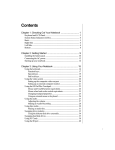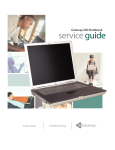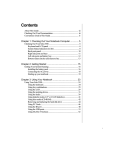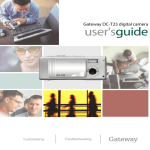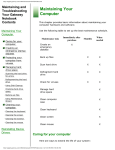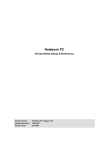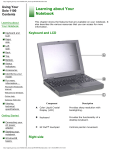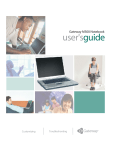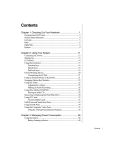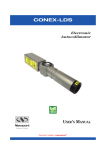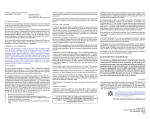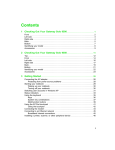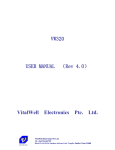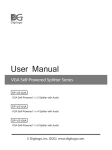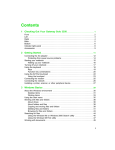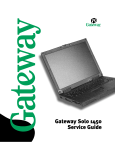Download SOLO 5100 USER MANUAL
Transcript
UsingYour Solo 5100 Multimedia Notebook All Rights Reserved This publication is protected by copyright and all rights are reserved. No part of it may be reproduced or transmitted by any means or in any form, without prior consent in writing from Gateway 2000. The information in this manual has been carefully checked and is believed to be accurate. However, Gateway 2000 assumes no responsibility for any inaccuracies that may be contained in this manual. In no event will Gateway 2000 be liable for direct, indirect, special, exemplary, incidental, or consequential damages resulting from any defect or omission in this manual, even if advised of the possibility of such damages. In the interest of continued product development, Gateway 2000 reserves the right to make improvements in this manual and the products it describes at any time, without notice or obligation. Trademark Acknowledgments AnyKey, cow spot motif, CrystalScan, Destination, Field Mouse, Gateway 2000, GW2K, HandBook, TelePath, Vivitron, stylized “G” design, and motto “You’ve got a friend in the business” are registered trademarks and EZ Pad, Family PC, and Gateway Solo are trademarks of Gateway 2000, Inc. Intel, Intel Inside logo, and Pentium are registered trademarks and MMX is a trademark of Intel Corporation. Microsoft, MS, MS-DOS, and Windows are trademarks or registered trademarks of Microsoft Corporation. All other product names mentioned herein are used for identification purposes only, and may be the trademarks or registered trademarks of their respective companies. Copyright © 1997 Gateway 2000, Inc. 610 Gateway Drive, N. Sioux City, SD 57049 USA Part #8502812 MAN SYS US SL51 USR GDE R1 2/98 In our effort to use nature’s resources efficiently and wisely, Gateway 2000 prints all manuals on recycled papers that meet the minimum requirements established by the Federal EPA in its guidelines for recycled paper products. Thank you for purchasing this Factory Service Manual CD/DVD from servicemanuals4u.com. Please check out our eBay auctions for more great deals on Factory Service Manuals: servicemanuals4u Regulatory Compliance Statements American Users Caution! The Federal Communications Commission warns the users that changes or modifications to the unit not expressly approved by the party responsible for compliance could void the user’s authority to operate the equipment. This device has been tested and found to comply with the limits for a Class B digital device, pursuant to Part 15 of the FCC rules. These limits are designed to provide reasonable protection against harmful interference in a residential installation. This equipment generates, uses and can radiate radio frequency energy and, if not installed and used in accordance with the instructions, may cause harmful interference to radio or television reception. However, there is no guarantee that interference will not occur in a particular installation. If this equipment does cause interference to radio and television reception, which can be determined by turning the equipment off and on, the user is encouraged to try to correct the interference by one or more of the following measures: ♦ Reorient or relocate the receiving antenna ♦ Increase the separation between the equipment and receiver ♦ Connect the equipment into an outlet on a circuit different from that to which the receiver is connected ♦ Consult the dealer or an experienced radio/TV technician for help. Accessories: This equipment has been tested and found to comply with the limits of a Class B digital device. The accessory associated with this equipment is the shielded power cord. This accessory is required to be used in order to ensure compliance with FCC rules. Canadian Users: This digital apparatus does not exceed the Class B limits for radio noise emissions from digital apparatus as set out in the radio interference regulations of Industry Canada. Le présent appareil numérique n’émet pas de bruits radioélectriques dépassant les limites applicables aux appareils numériques de Classe B prescrites dans le règlement sur le brouillage radioélectrique édicté par Industrie Canada Attention! Couper le courant avant l’entretien. ii Using Your Solo 5100 Multimedia Notebook This Information Technology Equipment has been tested and found to comply with the following European directives: European Users: [i]EMC Directive 89/336/EEC amending directive 92/31/EEC & 93/68/EEC as per -EN 50081-1:1992 according to EN 55022:1995 Class B EN 61000-3-2:1995 or EN 60555-2:1986 EN 61000-3-3: 1995 -EN50082-1:1992 according to EN 61000-4-2:1995 or IEC 801-2:1984 ENV 50140:1994 or IEC 801-3:1984 EN 61000-4-4:1988 or IEC 801-4:1998 [ii]Low Voltage Directive (Safety) 73/23/EEC as per EN 60950: 1992 This equipment is in the Class 2 category (Information Technology Equipment to be used in a residential area or an adjacent area thereto) and conforms to the standards set by the Voluntary Control Council for Interference by Information Technology Equipment aimed at preventing radio interference in such residential area. Japanese Users: When used near a radio or TV receiver, it may become the cause of radio interference. Read instructions for correct handling. This device has been tested and found to comply with the limits for a Class B digital device, pursuant to the Australian/New Zealand standard AS/NZS 3548 set out by the Spectrum Management Agency. Australian and New Zealand Users: Caution! Disconnect power before servicing. iii iv Using Your Solo 5100 Multimedia Notebook Contents Regulatory Compliance Statements ....................................................... ii Chapter 1: Checking Out Your System ..........................................7 Checking Out Your System .................................................................... 8 Chapter 2: Getting Started .............................................................11 Getting Started....................................................................................... 12 Connecting AC power.................................................................... 12 Powering up your notebook........................................................... 13 LCD Display................................................................................... 15 Keyboard ........................................................................................ 16 EZ Pad Plus Pointing Device......................................................... 22 Windows 95.................................................................................... 24 Chapter 3: Using Your System ......................................................27 Using Your System ............................................................................... 28 Battery Pack Bay............................................................................ 28 Option Bay...................................................................................... 30 Swapping modules ......................................................................... 31 External Floppy Disk Drive........................................................... 32 Removing and replacing the hard drive......................................... 32 Playing an Audio CD ..................................................................... 35 Built-in audio features.................................................................... 37 PC Cards......................................................................................... 43 About CardBus............................................................................... 44 Chapter 4: Connecting Ports and Peripherals .............................47 Connecting Ports and Peripherals......................................................... 48 Audio connectors............................................................................ 48 Composite Video Out port (NTSC)............................................... 49 USB (Universal Serial Bus) port ................................................... 50 Fast IR port ..................................................................................... 51 External computer monitor............................................................ 52 External mouse/keyboard .............................................................. 52 Printers............................................................................................ 53 v Chapter 5: Managing Power Consumption .................................55 Managing Power Consumption............................................................ 56 Batteries.......................................................................................... 56 Power menu ................................................................................... 57 Appendix A: Docking Solutions.............................................................. 62 Gateway Solo mini-docking station.............................................. 62 Gateway Solo docking station....................................................... 63 Appendix B: Contacting Gateway........................................................... 66 Calling Gateway ............................................................................ 66 Calling Gateway when outside the U.S. ....................................... 66 vi Using Your Solo 5100 Multimedia Notebook Chapter 1: Checking Out Your System Contents Checking Out Your System .................................... 8 Checking Out Your System Take a quick tour of your notebook to familiarize yourself with the options available. Color LCD display Power button EZ Pad Plus pointing device with scroll switch USB Ports PC Card slots Audio Ports Modular option bay (CD-ROM or Floppy disk drive) Keyboard and LCD panel Hard disk drive Cap access lock indicator Power indicator Using Your Solo 5100 Multimedia Notebook Scroll lock Modular option bay access indicator (CD-ROM / Floppy disk drive System indicator LEDs 8 Pad lock Battery charge indicator Parallel Power connector port Docking station port Serial port VGA port Composite video out Back ports panel Fast IR port PS/2 port Right side ports Kensington lock USB ports PC Card slots PC Card eject buttons Speaker out/ Headphone jack Mic Line Line in out Volume wheel Left side ports and PC Card slots Chapter 1: Checking Out Your System 9 Battery bay release latch Battery bay Modular option bay release latch Bottom release latches and memory bay 10 Using Your Solo 5100 Multimedia Notebook Memory bay Hard drive bay Chapter 2: Getting Started Contents Getting Started....................................................... 12 Connecting AC power.................................... 12 Powering up your notebook........................... 13 LCD Display................................................... 15 Keyboard......................................................... 16 EZ Pad Plus Pointing Device......................... 22 Windows 95.................................................... 23 Getting Started The best way to get familiar with your new notebook is to start exploring. This chapter tells you some of the things you may want to know first such as How do I turn it on?, What do those lights mean?, and Where do I find out more? To do that exploring, you will need power - the power that comes from either the electrical outlet (AC power) or from the battery. We suggest that you use the AC power first to allow your battery to get a full charge. Sometimes software applications will act strangely if the battery charge is low. Connecting AC power Your notebook is powered by one of the longest-lasting batteries available and was shipped to you partially charged, ready to use. You might, however, want to use the AC adapter to fully charge the battery and provide a constant supply of power while you are checking out some of the features. Your AC adapter comes as two parts: a power cord with a plug at one end and a flat connector at the other; and a cord with the adapter “block.” Connect the flat end of the cord to the adapter block, connect the post end of the cord to your notebook, and then the wall plug. Caution! Replace the power cord if it becomes damaged. The replacement cord must be of the same type and voltage rating as the original cord. 12 To connect the AC adapter 1. Connect the power cord to the AC adapter “block”. Using Your Solo 5100 Multimedia Notebook 2. Plug the AC adapter into your notebook's power connector, located at the back of your notebook near the right side. Warning! Do not attempt to disassemble the AC adapter. The AC adapter has no user-replaceable or user-serviceable parts inside. The AC adapter controls dangerous voltages that can cause serious personal injury or death. Contact Gateway about returning defective AC adapters. 3. Plug the power cord into an electrical outlet. Powering up your notebook Press in on the latch on the front face of your notebook to release the Liquid Crystal Display (LCD) lid, and lift to open. To turn on your notebook, press the power button, located in the upper right corner above the keyboard. The power button on your system is preset in On/Off mode. However, you can set it to function either in On/Off or Suspend/Resume mode using the setup screens (see “Power menu” on page 57). Power button Chapter 2: Getting Started 13 System Status Indicators (LEDs) The notebook status and various system modes are indicated by the system indicators. Following is a description of the indicators and what each means. Hard disk drive access indicator Power indicator Cap lock Pad lock Scroll lock Battery charge indicator Modular option bay access indicator (CD-ROM / Floppy disk drive ♦ Hard disk drive access light indicates that the hard drive is in use. ♦ Cap lock indicates that the caps lock is on. When the caps lock light is on, you type in all capital letters. ♦ Pad lock indicates that the pad lock is on. When the pad lock light is on, you can access the embedded numeric keypad. ♦ Scroll lock indicates that the scroll lock is on. When the scroll lock light is on, you can scroll through large volumes of text in some programs. ♦ Battery charge indicator has four modes of indication: • Green LED indicates the battery is fully charged • Yellow LED indicates the battery is charging • Red LED indicates a battery charging circuit malfunction • LED off indicates the AC adapter is not connected to the notebook ♦ Power LED indicates that the system is on; the power indicator LED glows green if the CPU is being actively utilized, yellow CPU if utilization is low, and red if there is a problem with the processor. A red LED is highly unusual; if it remains red after rebooting the system, contact technical support. ♦ Modular option bay access indicator (CD-ROM or Floppy disk drive) indicates that the CD-ROM or the floppy drive is in use. 14 Using Your Solo 5100 Multimedia Notebook LCD Display Your notebook features a built-in, backlit, color Liquid Crystal Display (LCD). Each XGA display provides sharp, crisp resolution with an anti-glare screen. Tilt your notebook's cover forward or backward to adjust the viewing angle. Press the <Fn> key together with the <Up Arrow> or <Down Arrow> keys to control display brightness. Note: Some screens may have a small number of colored dots when viewed in the “Black” mode. This is normal and does not affect the overall screen image. Chapter 2: Getting Started 15 Keyboard Your notebook features a full-size keyboard. To provide the full functionality of a desktop computer keyboard, many of these keys have been assigned alternate functions, including shortcut keys for Windows 95 and Status Display menus. Fn keys for function key combination Function keys For normal key functions: ♦ Press the key alone to get standard lower case letters, numerals and punctuation marks. ♦ Press the key together with the <Shift> key to get standard upper case letters and symbols. 16 Using Your Solo 5100 Multimedia Notebook Special keys The following keys help you accomplish shortcuts when working with some software: Key Description Will print the screen if an external printer is connected to your notebook (DOS only). In Windows 95 this key combination puts the screen content into the clipboard. You can then paste it into a program such as Paint to display or print it. System Request is reserved for certain applications such as some DOS programs. Some software use these keys to help you quickly navigate through the software, documents or other functions. Reference the software manual to determine how the keys function with the software. Use this key to display the Windows Start menu. Use this key to provide quick access to shortcut menus and help assistants in Windows. Chapter 2: Getting Started 17 Function keys Press the <Fn> key together with one of the following keys (with blue letters) to get these specific functions: Key Combination Description + Displays the power status display for the Popup Status Display program in the upper left corner of the desktop. Press the key combination again to make the display disappear. Toggles between the LCD display, external monitor, both displays at the same time, or NTSC/PAL as the active display. Places the system in Standby mode. Press any button or key on the keyboard to resume using your notebook. Places the system in Suspend mode. Press the power button to resume power to the notebook. Makes temporary changes to the power management (PM) mode settings by toggling the settings from Savings, Perform, Disabled, and Custom. The changed setting is displayed each time the button is pressed. To view the settings without changes, use the Fn+F2 combination. After about 30 seconds, the display disappears. Enables the Pad Lock function, so you can access the embedded numeric keypad. The Pad Lock LED stays lit while this function is enabled. Press the key combination again to make the display disappear. In some programs you can scroll through large volumes of text. The Scroll Lock LED stays lit as long as this function is enabled. 18 Using Your Solo 5100 Multimedia Notebook Key Combination Description + In some programs this key combination pauses the display when text is scrolling very quickly. Press any key to restart the text flow. In some programs this key combination breaks the text. Increases LCD brightness when the key combination is pressed repeatedly. Decreases LCD brightness when the key combination is pressed repeatedly. Chapter 2: Getting Started 19 Pad Lock Keys Press the <Fn> and <Pad Lock> keys together, together with one of the following keys to activate the numeric keypad: Key Combination Description + Pressing the 7 key produces a 7 when the Pad Lock function is enabled. Pressing the 8 key produces an 8 when the Pad Lock function is enabled. Pressing the 9 key produces a 9 when the Pad Lock function is enabled. Pressing the 0 key produces a / when the Pad Lock function is enabled. Pressing the U key produces a 4 when the Pad Lock function is enabled. Pressing the I key produces a 5 when the Pad Lock function is enabled. Pressing the O key produces a 6 when the Pad Lock function is enabled. Pressing the P key produces an * when the Pad Lock function is enabled. 20 Using Your Solo 5100 Multimedia Notebook Key Combination Description + Pressing the J key produces a 1 when the Pad Lock function is enabled. Pressing the K key produces a 2 when the Pad Lock function is enabled. Pressing the L key produces a 3 when the Pad Lock function is enabled. Pressing the ; key produces a - when the Pad Lock function is enabled. Pressing the M key produces a 0 when the Pad Lock function is enabled. Pressing the / key produces a + when the Pad Lock function is enabled. Pressing the . key produces a . when the Pad Lock function is enabled. Chapter 2: Getting Started 21 EZ Pad Plus Pointing Device Caution! Do not use a pen or pencil, only your fingertip, on the EZ Pad Plus pad. Like a mouse, the EZ Pad Plus pointing device controls the movements of the cursor on the screen. Press a finger lightly against the pad, then slide it in the direction you want the cursor to move. Use the buttons or tap on the pad to select something. EZ Pad Plus Touchpad buttons Rocker switch You can use the EZ Pad Plus rocker switch while using some Microsoft programs (e.g. Word, Excel, Internet Explorer) to scroll through a document in addition to the traditional point and click: To scroll: ♦ Press forward or backward on the rocker switch to scroll through documents, similar to using traditional scroll bars. To click: ♦ Position the cursor on the item and press the left button once. or ♦ Position the cursor on the item and tap on the pad once. To double-click: ♦ Position the cursor on the item and press the left button twice. or ♦ Position the cursor on the item and tap on the pad twice. 22 Using Your Solo 5100 Multimedia Notebook To drag and drop: ♦ Position the cursor on the item and hold down the left button while sliding your finger to reposition the cursor, then release the button. or ♦ Position the cursor on the item and tap on the pad twice; after the second tap, hold and slide (without lifting your finger) to reposition the cursor, then lift your finger to release. Customizing the EZ Pad Plus You can customize the EZ Pad Plus to work the way you want when you set button configuration, drag, edge motion, or cursor’s speed, rate, and size. To customize the EZ Pad Plus 1. Click on Start, Settings and Control Panel. Double-click on the Mouse icon. 2. Click on each of the different tabs to see the options available. You also can attach an external mouse to the notebook through the PS/2 port on the right side of the notebook or the USB ports if the mouse is USB compatible. The optional docking station solutions also offer ports for external mouse connections. It is not necessary to shut down the system when connecting an external mouse. To use some external pointing devices, you may need to disable the EZ Pad Plus. Windows 95 Your notebook is pre-loaded with the Windows 95 operating system software and other programs that you ordered. Once you turn on your system, the Welcome to Windows 95 screen appears on the display. Chapter 2: Getting Started 23 This screen provides a Windows tour, information about what's new, the opportunity to register your software online, information about Windows products and useful tips. Click the Windows Tour button to start a brief tour of the operating system. This tour provides information on starting a program, exploring your disk, finding a file, switching windows, and using Help. Click on the button next to the topic that you are interested in, then follow the screen prompts. If you have any questions about the instructions, click on the Show Me button. Click on the Exit button and follow any screen prompts (when you are finished). Click on What’s New for information more experienced users might find useful. This screen gives an overview of changes between earlier versions of Windows and Windows 95. Click on the box next to the topic you are interested in. Click on the X in the upper right corner of the window to close the screen. Click on the Online Registration button to register your software using a tollfree number. You will need a modem to access this option. Click on Product Catalog to see what other Windows options are available for purchase. You must load the Windows 95 CD-ROM in the CD-ROM module to access this option. Clicking Next Tip provides operational tips, which are displayed in the Did you know... section of the Welcome to Windows 95 screen. Click on either the Close button, or the X in the upper right corner of the Welcome screen to close it, and start using Windows 95. 24 Using Your Solo 5100 Multimedia Notebook Start button The Start button is located in the bottom left corner of the Windows 95 desktop and accesses the Start menu. Most programs and applications are launched via the Start menu. To access the menu, click on the Start button or press one of the keys, located on either side of the Alt keys next to the spacebar. Taskbar The taskbar is located along the bottom of the Windows 95 desktop. The task bar contains the start button in the left corner and displays all active/running programs. If a program has been minimized, click on the program name in the taskbar to restore it. If you need additional help: If you have additional questions, check the online documentation or a printed manual. For online documentation, check the Help option in each software package. The Windows 95 manual you received with your notebook is a reference for Windows 95 questions. If you purchased your notebook in the US, you can order other printed manuals at an additional cost through the Document Offer Program. Order forms are included in the information pack that came with your system software CDs. Chapter 2: Getting Started 25 26 Using Your Solo 5100 Multimedia Notebook Chapter 3: Using Your System Contents Using Your System ............................................... 28 Battery Pack Bay............................................ 28 Option Bay...................................................... 30 Swapping modules ......................................... 31 External Floppy Disk Drive........................... 32 Removing and replacing the hard drive......... 32 Playing an Audio CD ..................................... 35 Built-in audio features.................................... 37 PC Cards ......................................................... 43 About CardBus............................................... 44 Using Your System Swapping batteries, the CD-ROM module, the floppy disk drive module, hard drives, and PC Cards (such as modems) are every-day tasks that are easily accomplished on your notebook. This chapter explains how to swap these modules and how to use them to play CD-ROMs, make an audio recording, and connect the PC Cards. Battery Pack Bay Battery packs can be “warm-swapped” in the battery bay. This means you can change battery packs while in Suspend mode. To remove the battery pack Warning! There is a danger of explosion if an old, wornout battery is incorrectly replaced. Replace only with the same or equivalent type recommended by the manufacturer. Dispose of used batteries according to the manufacturer’s instructions included with the new battery packaging. 28 1. Save all work. 2. Press the <Fn> key together with the <F5> (Suspend) key to put the system into suspend mode. 3. Close the cover and turn your notebook over. 4. Slide the battery release latch back to release the battery. Using Your Solo 5100 Multimedia Notebook 5. Hold the latch back and lift the battery up out of the battery opening. To replace the battery pack 1. Place the battery pack into the battery bay, pushing downward until it “snaps” into place. 2. Turn the notebook right side up and open the cover. 3. Press the power button (quick press and release) to resume power to the system. Chapter 3: Using Your System 29 Option Bay The Gateway Solo 5100 Multimedia Notebook features a modular option bay located in the front panel of the notebook. This bay accepts the CD-ROM module or the floppy disk drive module. Modular option bay To use CD-ROM and floppy disk drive functions simultaneously, first install the modular CD-ROM drive into your notebook. Connect an external floppy drive to the parallel port at the back of your notebook using the optional adapter cable. 30 Using Your Solo 5100 Multimedia Notebook Swapping modules The CD-ROM module can be exchanged for the floppy disk drive module in the modular option bay. Each time you change them out, however, you must reboot your system. Note: Be sure to save and exit any applications before initiating any of the following procedures. To switch between CD-ROM and floppy disk drive modules 1. Save all work, then follow your operating system’s Shut Down procedure to turn it off. 2. Close the cover and turn your notebook over. 3. Locate the modular bay access latch. Slide the latch open and use the grip near the front of the notebook to pull the CD-ROM module out of the notebook. . Chapter 3: Using Your System 31 4. Turn your notebook back over and install the floppy disk drive module. 5. Firmly push the floppy disk drive module straight into the bay until the latch “clicks” into place and is firmly seated. If you don't hear the “click,” try it again. External Floppy Disk Drive Your floppy disk drive module can be used as an external drive by using the optional adapter cable to connect to the parallel port at the back of your notebook. You can then have a CD-ROM in the modular option bay and have the use of the floppy disk drive, which normally resides in the modular option bay. It is not necessary to reboot the system for it to recognize the connection. Removing and replacing the hard drive You can remove your notebook's hard disk drive (HDD) from your notebook for replacement, or to switch between optional additional hard drives. 32 Using Your Solo 5100 Multimedia Notebook To remove and replace the hard disk drive 1. Save all work. 2. Use your operating system’s Shut Down procedure to turn your notebook completely off. 3. Close the LCD lid. 4. Disconnect the AC power (if plugged in to the notebook). 5. Turn your notebook over and locate the hard drive latch. 6. Unscrew the hard drive retaining screw. Chapter 3: Using Your System 33 7. Gently pry the hard drive latch up and out of the seated position. Slide the hard drive forward and lift it out of the hard drive tray. 8. Place the new hard drive into the hard drive tray; slide it back into position so that the connector plug is firmly seated into the drive’s plug-in. 9. Seat the latch down into position and secure with the screw. Then turn your notebook back over and reconnect the AC power (if necessary). 34 Using Your Solo 5100 Multimedia Notebook Playing an Audio CD Note: Your notebook contains all the key features needed to enjoy your favorite audio CDs. Power (either battery or AC) must be supplied to your notebook before you can open the CD-ROM tray. To play an audio CD 1. Make sure the CD-ROM module is installed in the modular option bay. Volume wheel CD-ROM module Eject button CD-ROM manual release — to eject without power Note: 2. Press the Eject button on the front of the CD-ROM module. 3. Gently pull the CD-ROM tray fully open and place the audio CD into the tray. 4. Push in the CD-ROM tray until it closes completely. 5. After a few seconds, the CD-ROM will start playing automatically. If power is unavailable and you need to remove a CDROM disk, you may manually eject the CDROM tray using a thin prodding device such as the end of a paper clip inserted into the CD-ROM manual release hole. Chapter 3: Using Your System 35 6. Click on the CD Player option that appears in the taskbar along the bottom of the display, or click on Start, Programs, Accessories, Multimedia, and CD Player to access the CD Player screen. You can change music tracks, view playing times, control the volume, set preferences, define a play list and even set the system to continuous or random play through the CD Player screen. Click on the CD Player button after it appears in the Taskbar to display the CD Player window on the desktop as shown below 7. Slide the mouse pointer slowly over the control buttons on the CD Player screen to display the function of each button. To remove a CD 1. Click on the Eject button in the CD Player screen, or press the eject button on the front of the CD-ROM drive when you have finished listening. 2. Gently pull the CD-ROM tray fully open and remove the CD; then close the tray. Experiment with the different settings in the CD Player screen to find the ones that work best for you. 36 Using Your Solo 5100 Multimedia Notebook Built-in audio features Speakers and internal microphone This system contains a built-in microphone and stereo speakers. To control the volume: ♦ Use the Volume wheel located on the side of your notebook. Rotating it towards the back increases the volume while rotating it forward decreases the volume. ♦ Or, click on Start, Settings and Control Panel. Double click on the Multimedia icon. You can change the volume from the Audio tab. ♦ Or, click on the speaker icon in the lower right corner of the taskbar. A volume control screen will appear. Using the EZ Pad Plus pad, slide the pointer up or down to change the volume setting. Click once anywhere on the Windows 95 desktop to close the screen. ♦ Or, double-click on the speaker icon in the lower right corner of the taskbar. A more detailed volume control screen will appear, containing volume and balance controls for master volume control, wave, CD audio and 3D Enhancement settings. Using the EZ Pad Plus pad, slide the pointers to the left or right to control balance, or up or down to change the volume setting. To adjust the 3D Enhancement settings, first make sure Advanced Controls is checked on the Options Menu, then click on the Advanced box to change the settings. Use the audio ports on the left side of your notebook, or the audio ports on the optional docking station to add external speakers, headphones or a microphone. Playing a MIDI file The notebook has two musical instruments capable of playing back MIDI files. These instruments consist of: ♦ A four-operator FM synthesizer with 16 voices. FM synthesis creates complex sounds by mixing simple waveforms; it is a primitive form of synthesis included primarily for compatibility with games and entertainment software. Chapter 3: Using Your System 37 Note: General MIDI is an extension of the basic MIDI specification that assigns specific patch numbers to specific instruments. ♦ A software wavetable synthesizer, which provides much more realistic MIDI playback quality using digital samples (recordings) of actual instruments. It also includes general MIDI compatibility to ensure proper playback of most MIDI files. You can choose to use either FM or wavetable synthesis when playing back MIDI files. For best sound quality, we recommend the software wavetable synthesizer. To select a music synthesizer 1. Click on Start, Settings, Control Panel, and double-click on the Multimedia icon. The Multimedia Properties control panel appears. 2. Select the tab labeled “MIDI.” The MIDI control panel appears: Select Midi for Internal ESS Software Wavetable if you want the software wavetable synthesizer. You can play back most .MID or .RMI MIDI files with the Media Player accessory supplied with Windows 95. If you want to create and edit MIDI files, consider purchasing a commercially available MIDI sequencer software application available from software retailers or music stores. 3. Click on OK when you are finished selecting a music synthesizer. 38 Using Your Solo 5100 Multimedia Notebook To play back a MIDI file 1. Click on Start, Programs, Accessories, Multimedia, and click on the Media Player icon. The Media Player appears on the display. 2. From the File menu, select Open. A list of sample files supplied with Windows 95 appears; click on the Files of type drop down box to select MIDI Sequencer file types. This will show only MIDI type files. Double-click on the file of your choice, then click on the (Play) button in Media Player. The sequence should begin playing. If you can't hear it, make sure that the volume control wheel on the side of the notebook is turned up. If you hear a strange rhythmic pattern played by a non-percussion instrument when playing back a MIDI file, the percussion instrument channel is probably set incorrectly. It is generally accepted that percussion instruments should go on MIDI channel 10, and this is the default setting for Windows 95. However, you may encounter a MIDI file that plays percussion instruments on channel 16 instead. Playing back such a file with the software wavetable Chapter 3: Using Your System 39 synthesizer default channel 10 percussion setting creates bizarre effects, such as a snare drum or cymbal part played back on an electric piano, and a bass drum on a flute. To correct this wavetable synthesizer channel: 1. Click the “Advanced” tab in the Multimedia Control Panel to bring up the list of multimedia devices installed on your system. Click the + beside MIDI Devices and Instruments. 2. Double-click on the instrument MIDI for Internal ESS Software Wavetable. 3. Click on the “Details” tab. 40 Using Your Solo 5100 Multimedia Notebook 4. Click on the Percussion on Channel 16 option, click Apply, then click on OK. 5. Try playing the sequence again. This time, the percussion instruments should play correctly. When you're finished playing this file, be sure to set this control panel option back to “General MIDI Instrument,” or you'll encounter the same problem when trying to play back a normal MIDI file with percussion instruments on MIDI channel 10. Playing external MIDI modules or keyboards You can use a MIDI sequencer on your notebook to play through external MIDI modules or keyboards. To do this, you need one of the optional Solo docking solutions that has a MIDI/Game port. You also need a standard MIDI connector that converts the Game port connector to standard 5-pin MIDI In and Out connectors. The connector is available from various musical instrument retailers. Chapter 3: Using Your System 41 Making an Audio Recording Note: Connecting an external microphone will disable the built-in microphone. Use the built-in microphone, or connect an external microphone using the Mic port on the left side of your notebook to make an audio recording. . Mic To make an audio recording 1. Click on Start, Programs, Accessories, Multimedia, then Sound Recorder to access the Sound Recorder screen. 2. Click on Edit and Audio Properties to set/check record volume levels. 3. Click on File and New to begin a recording. 4. Slide the mouse pointer slowly over the control buttons along the bottom of the screen to display the function of each button. 5. Click on the ● (Record) button to start recording. 6. Click on the ■ (Stop) button to end recording. 7. Click on File and Save As... to name and store the recording. You can play back the recording in either Sound Recorder, or Media Player. To play back the recording in Media Player 1. Click on Start, Programs, Accessories, Multimedia, then Media Player to access the Media Player screen. 2. Click on File, then Open.... 3. Select the file to play back and click the Open button. 42 Using Your Solo 5100 Multimedia Notebook 4. Slide the mouse pointer slowly over the control buttons along the bottom of the screen to display the function of each button. 5. Click on the (Play) button to start the playback. 6. Click on the ■ (Stop) button to end playback. PC Cards Your notebook’s PC Card slots (also known as PCMCIA card slots) are located behind the PC Card doors on the left side of your notebook. These slots accept two Type II PC Cards or one Type III card. Your notebook is pre-configured to automatically accept most PC Cards. Note: Some PC Cards, such as Zoomed Video cards, may require additional drivers. Refer to the PC Card’s documentation. To insert a PC Card 1. Select a PC Card (such as a modem) to insert. 2. Locate the PC Card slot in which you wish to insert the card. If you are installing a Type III PC Card, it must be inserted into the bottom slot. PC Card slots PC Card eject button Chapter 3: Using Your System 43 3. Slide the card into the chosen slot. The first time you insert a PC Card, follow the installation steps in the Windows prompts. When the card is installed correctly, your notebook emits a two-toned beep. Operate the device as recommended in the PC Card's manual. To remove a PC Card 1. Click on the PC Card icon in the taskbar. 2. Using your mouse, click on the card that you want to remove. A screen will appear stating when it is safe to remove the PC Card. Click on OK. 3. If the folding Eject button is in the recessed position, rotate the button to the eject position, then press the eject button to remove the card. You do not need to reboot your notebook when changing most cards because your notebook supports “hot-swapping.” This means you can usually insert a PC Card and have it recognized by the system without shutting down your notebook or even putting it into Suspend mode. See your PC Card's documentation for further information. About CardBus The 32-bit CardBus technology (sometimes referred to as “PC Card 32 cards”) supports DMA and bus mastering technologies that are useful in performanceintensive applications like full-motion video, high speed network connections, fullmotion video capture and display, and high performance peripheral interfaces. 44 Using Your Solo 5100 Multimedia Notebook While not many 32-bit CardBus cards are on the market yet, you can use them interchangeably with 16-bit cards in your notebook. However, please note that some docking solutions do not support CardBus. CardBus cards function only in your notebook's PC Card slots. Caution! Be sure to wait for the “Safe to remove” message before you remove the CardBus card, or you may crash your system and lose all your work. Using a Modem Installing and using a modem with your notebook is usually an easy process. If you have ordered a modem with your notebook, the drivers for the modem have already been loaded onto your notebook. The modem may need different adapters depending upon the country in which it is used. The XJACK modem (shown below) is available for purchase only in the United States. European customers may purchase a modem with an external DAA. To install the TelePath data/fax modem 1. Using the 15-pin connector: Plug the 15-pin connector end of the modem cable into the end of the modem. If you have trouble plugging it in, turn the connector over. Caution! Do not use your modem on a digital phone line. If you attempt to use the modem on a digital line, the TelePath data/fax modem has built-in protection, and thus will not work. Other modems, however, could be ruined. Most digital lines are found in hotels or businesses with special inhouse phone systems. . Or: (see next page) Chapter 3: Using Your System 45 Using the XJACK: Gently push on the end of the jack and release. The jack will pop out. Plug an RJ-11 connector from above into the XJACK. . 2. Insert the modem face up 68-pin connector first, into the PC Card slot in the left rear side of the notebook. Press the modem gently, but firmly into the PC Card slot until it will go no farther. Do not force the modem. 3. Plug the jack end of the modem cable into the wall jack. If you are using an XJACK modem and need a longer cord for your modem, use an RJ-11 connector and extension telephone cable. 4. The modem is now enabled and ready to use. 46 Using Your Solo 5100 Multimedia Notebook Chapter 4: Connecting Ports and Peripherals Contents Connecting Ports and Peripherals......................... 48 Audio connectors............................................ 48 Composite Video Out port (NTSC)............... 49 USB (Universal Serial Bus) port.................... 50 Fast IR port ..................................................... 51 External computer monitor ............................ 52 External mouse/keyboard............................... 52 Printers ............................................................ 53 Connecting Ports and Peripherals Your notebook has several ports and a variety of hardware connections, allowing you to connect to peripheral devices or to other computer systems. The available ports include parallel port, serial port, audio connectors, video port, docking station port, USB port and the Fast IR port. These allow you to use peripherals such as an external monitor, external mouse or keyboard, audio and video equipment, electronic keyboards, and printers. The ports on the back of your notebook are covered by a two-way door: the hinged flap allows access to all the ports. A special sliding panels opening in the hinged flap allows access just to the docking station port. Audio connectors Your notebook comes with four audio connectors on the left side. From the left, the ports include the microphone (mic), line in, line out, and speaker out. All audio connectors use the standard 1/8” jacks. Mic Line out Line in Speaker out/ Headphone jack The microphone port is compatible with monaural electret or dynamic microphones. When an external microphone is plugged into this connector, the built-in omni-directional microphone is automatically disabled. The line in and line out ports are high-impedance audio stereo connectors and are intended for use with similar impedance stereo connectors, like those found on home stereo systems and components. Use the line in connector to record from another computer, stereo equipment or a VCR. The line out jack is not capable of driving un-amplified speakers or headphones, but can be used for amplified speakers. 48 Using Your Solo 5100 Multimedia Notebook The speaker out jack is a low-impedance amplified stereo audio output and is intended for use with headphones, small unamplified speakers or amplified speakers. This connector can provide up to .5 Watt RMS per channel into an 8 ohm load. The volume control wheel on the left side controls the speaker out port and the internal speakers. The volume level for the other ports is controlled by the multimedia software. To access that control panel, click on Start, Settings and Control Panel. Double click on the Multimedia icon. You can change the volume from the Audio tab. Composite Video Out port (NTSC) The Composite Video (NTSC) Out port (color coded yellow) allows you to display your notebook's screen on a TV screen by connecting the notebook to the TV or VCR using a standard video connecting cable. This option is typically used with large-screen TVs to give demonstrations and presentations. Composite video out To connect the notebook and TV, plug one end of the cable into the Composite Video Out jack on your notebook and the other end into the Video In connector on your television or VCR. To view the new display, use the key combinationFn+F3 to switch to NTSC/PAL. You should see the display on the TV screen only. If the display is distorted, check to see if the BIOS setting is correct for NTSC or PAL (NTSC is primarily used in the United States). For optimal usage, set the notebook's display to 640 by 480 pixels. Because a TV screen's display is of a lower resolution, large fonts should be selected to maximize on-screen viewing effectiveness. Chapter 4: Connecting Ports and Peripherals 49 To change the display resolution 1. Click on the Monitor icon on the taskbar. 2. Select the desired resolution (640 by 480). 3. Click on Apply, then on OK. If the Monitor icon does not appear on your taskbar, right click on the desktop, click on Properties and then Settings. Check the box that says “Show settings on taskbar.” USB (Universal Serial Bus) port USB is a serial interface that serves as a single-port alternative to connecting devices that traditionally have required their own specific ports such as printers, joystick/MIDI devices, scanners, an external mouse or keyboard. The USB detects when devices are added or removed, then automatically determines what host resources are needed. The USB makes those resources, including driver software and bus bandwidth, available to the peripheral without any intervention. USB ports Note: This section on USB drivers applies only if you purchased your notebook in the United States and have the USB drivers on a CD rather than on a diskette. 50 Your notebook has two USB ports where two peripheral devices, such as a keyboard or monitor, can plug directly into the notebook. If you have an expansion hub built into an external keyboard or monitor, or if you have a stand-alone USB box, you can connect even more peripherals (currently up to 127 different devices) at the same time. Examples of common devices that connect to the USB (but must be USB compatible) include keyboards, joysticks, mice and peripherals such as telephones, modems, printers, microphones, digital speakers, scanners, digital cameras and game controllers. Using Your Solo 5100 Multimedia Notebook Your notebook shipped with the USB ports enabled, however, you must load the peripheral's drivers according to instructions from the USB device manufacturer. Fast IR port The Fast IR (infrared) port built in your notebook and a transfer module (optional) use infrared technology to send signals between the notebook and a remote system. The IR port is located on the right side of your notebook. It can send as well as receive signals. A variety of desktop computers, printers and other peripherals are IR-compatible. Fast IR port Placing your notebook's IR port within about three feet (or one meter) of another unit's IR port (and using transfer software) allows you to send to or receive information from that remote desktop computer, printer or other peripheral. The optional transfer module (receiver/transmitter) must be placed no farther away than about three feet (or one meter), with the module's IR port directly facing your notebook's IR port. The other end connects to the remote system's serial port. Your notebook is shipped with the Fast IR port; however, it must be enabled before using. Using the Fast IR Port To use the Fast IR Port option, first check in the Control Panel for the Infrared icon. If you don't see the icon, infrared support needs to be installed. In Windows 95, double click on the Infrared icon in the Control Panel to get to the Infrared Monitor window. Click on the Options tab (with Infrared enabled) to make changes. Windows 95 creates two virtual ports that IR devices use: usually LPT3 for printers and COM4 for serial transfers. This can be verified by checking the settings in the Infrared Monitor program. If you wish to install an IR printer, make sure it is set up Chapter 4: Connecting Ports and Peripherals 51 on the LPT3 port. To transfer files, use serial or wireless transfers on COM4. If fast IR drivers are installed but you are having communication problems, try changing the “Limit connection speed to” setting to 115.2kps. External computer monitor Connect an external computer monitor to your notebook through the VGA port on the back of your notebook or the VGA port on the optional mini-docking station. Press the Fn key with the F3 (LCD/CRT) key to toggle between active displays. Depending upon the external monitor, you might have to lower the video resolution to 640 X 480, toggle the video to the external monitor only, or do both. Parallel port VGA port External mouse/keyboard Connect an external mouse or keyboard through the PS/2 port on the right side of your notebook, or the PS/2 (keyboard) port on the optional docking station solution. It is not necessary to reboot your system. If the mouse or keyboard are USB compatible and the USB drivers are loaded, they can be connected using the USB ports. PS/2 port 52 Using Your Solo 5100 Multimedia Notebook Printers Windows 95 allows you to connect to most brand name printers. After you connect the printer cable to the appropriate port (parallel or USB) on your notebook, you need to set it up using the Add Printer Wizard. To add a printer 1. Click Start, Settings, then Printers. 2. Double-click on the Add Printer icon, then follow the instructions from the Add Printer Wizard. Chapter 4: Connecting Ports and Peripherals 53 54 Using Your Solo 5100 Multimedia Notebook Chapter 5: Managing Power Consumption Contents Managing Power Consumption ............................ 56 Batteries .......................................................... 56 Power menu.................................................... 57 Managing Power Consumption A battery-powered session for your notebook is affected by many things such as using screen savers rather than the suspend function, or playing music CD-ROMs while using a word processor. If there is no AC power outlet nearby, you will want to make the battery-powered session last as long as possible. This chapter tells you how to extend the battery-powered session time by using the following tips or by changing the power settings in the Power menu. Some quick tips about conserving battery power include: ♦ If you tend to startup and shutdown several times on one battery charge, use Suspend instead. Using Resume instead of starting up takes less power. ♦ Remove PC Cards when not in use. ♦ Set battery for maximum battery performance in Settings (see discussion below). ♦ Dim the display as low as is comfortable. Batteries The battery must be installed in the notebook and connected to an AC power source to charge completely. The battery will charge if your notebook is operating, as long as the AC adapter is properly connected. The notebook can run on a fully charged battery for about two hours of normal use before the battery needs recharging. Battery status You can check the battery status using any of several ways. ♦ Position the cursor over the power cord (AC) or battery icon in the lower right corner of the taskbar. A battery status screen will appear. Moving the cursor anywhere on the display causes the screen to disappear. ♦ Or, click twice on the power cord or battery icon in the lower right corner of the taskbar. A more detailed battery status screen will appear. Click on the X in the upper right corner of the screen to close it. 56 Using Your Solo 5100 Multimedia Notebook ♦ Or, click on Start, Settings and Control Panel. Double click on the Power icon. You can view the battery status and set power preferences from this screen, which stay in effect until they are changed in Windows. Click on the X in the upper right corner of the screen to close it. ♦ Or, press the <Fn> key together with the <F2> (Status) key. The power status display appears in the upper left corner of the display. This display monitors battery status and power management selection. BAT1 monitors the status of the battery pack in the battery bay. Press the <Fn> and the <F2> (Status) keys again to make the display disappear. When the battery power level gets low: ♦ The system emits three beeps. ♦ The battery icon in the lower right of the taskbar has a red “X” over it. ♦ The Low Battery screen appears, advising you to change your battery or switch to AC power immediately to prevent losing your work. Connect the AC adapter to the notebook to recharge the battery. Power menu The Power menu is a part of the BIOS Setup Utility that contains the power management settings and system timeouts. These settings are stored and saved even when the power is off. Use the Power menu to make changes to the system to improve the battery-powered session time and performance. The rest of the BIOS Setup Utility screens are discussed in Maintaining and Troubleshooting Your Solo Notebook. The Power menu screen shown may differ somewhat from that shown here as you may have a newer BIOS than described here. The screens will be similar enough to get the information you need; if there are differences, follow the on-screen instructions and helps. To access the Power Setup menu 1. Power up your notebook. 2. Press the <F2> key when prompted to do so. The “Entering Setup...” message briefly shows and then the Main menu appears. Chapter 5: Managing Power Consumption 57 3. Use the Arrow right key to navigate to the Power menu. Use the keys identified at the bottom of the screen to navigate through the different options. An Item Specific Help bar providing additional information is also located along the right side of each menu. PhoenixBIOS Setup Utility Note: The Power menu screen shown may differ somewhat from that shown here. If there are differences, follow the on-screen instructions and helps. Main Advanced Security Power Boot Exit Item Specific Help Power Switch: Lid Switch: Low Battery Beep: Cooling Control: [On/Off] [Suspend] [Enabled] [Performance] Suspend Mode: [Suspend] Auto Save To Disk: [Off] >AC Mode Power Savings >DC Mode Power Savings Resume On Time: [Off] Resume Time: [00:00:00] Resume on Modem Ring: [Off] F1 Help ↑↓ Select Item -/+ Change Values F9 Setup Default ESC Exits ←→ Select Menu Enter Select > Sub-Menu F10 Save and Exit The settings you are most likely to change include: Power switch: Sets power switch functionality; when you press the power button, the system can be set to either shut down or suspend. Press the <Spacebar> to select On/Off or Suspend/Resume. Lid switch: Sets lid switch functionality; when you close the LCD panel the system can be set to either shut down or suspend. Press the <Spacebar> to select On/Off or Suspend/Resume. Cooling Control: Selecting Performance makes the fan come on at a lower temperature and leaves the CPU running at full speed (the system is noisier but has better performance). Selecting Silence keeps the fan from coming on, but as the temperature starts to rise, the CPU speed slows down. Use the <Spacebar> to select Performance or Silence. Or the sub-menus: AC Mode Power Savings or DC Mode Power Savings. Both settings allow you to choose between Maximum Performance, Maximum Power Savings, or Customized settings. Customized allows you to change the timeout settings depending on whether you are using the AC adapter or battery (DC) power. 58 Using Your Solo 5100 Multimedia Notebook Power button (switch) settings Note: When the power switch setting in the Power (BIOS Setup) menu is On/Off and your notebook is: ♦ off, press the power button to turn your notebook on. ♦ on, press the power button to turn your notebook completely off. When the power switch setting in the Power menu is Suspend/Resume and your notebook is: Turning your notebook completely off when the power button is set for On/ Off mode causes every part of your notebook to turn off. Any unsaved work will be lost! Pressing the power button will reboot your notebook. ♦ off (or in Suspend mode), press the power button to resume power to your notebook. ♦ on, press the power button to cause your notebook to enter Suspend mode. Press and hold the power button for about four seconds to turn your notebook completely Off. Caution! Any unsaved work can be lost if you hold the power button down for too long. To change the power button setting 1. Power up your notebook. 2. Press the <F2> key when prompted to do so. The “Entering Setup...” message briefly shows and then the Main menu appears. 3. Using the <Right Arrow> key, move to the Power menu. 4. The first available option is Power Switch:. If the setting displayed is the one you want, go to Step 6. 5. Press the <Spacebar> to change the setting. 6. Press the <Esc> key to access the Exit menu. Press <Enter> to Save changes and exit, then press <Enter> or use the <Down Arrow> key to select any other option. Chapter 5: Managing Power Consumption 59 Status Display The Status menu displays appear in the upper left corner of the screen, and disappear after about 30 seconds of inactivity. Status menus: ♦ Power status display ♦ Contrast meter ♦ Brightness meter Note: These changes in power management levels are temporary and do not affect the power settings in the BIOS Setup screens. The changes are only in effect until the system is rebooted or powered off, then the original BIOS power settings are restored. Power status display: This display appears when you press the <Fn> key together with the <F2> (Status) key. It shows current battery status, power management level, BIOS and keyboard controller version. The display is updated when you change any function choice. The AC power status is monitored on the first line. Battery status is displayed on the second line and is displayed as a percentage where 100% represents a fully charged battery. The power management levels are displayed in the third and fourth lines. You can toggle between levels by pressing the, <Fn> key together with the <F6> (Pwr Mgmt) key. The fifth and sixth lines display the version numbers of the system ROM and keyboard controller. Brightness meter: This meter shows the brightness level for the LCD display. Press the <Fn> key and tap the <Up Arrow> or <Down Arrow> key to increase or decrease the brightness level in single increments. 60 Using Your Solo 5100 Multimedia Notebook Appendix A: Contents Docking Solutions ................................................. 62 Gateway Solo mini-docking station .............. 62 Gateway Solo docking station ....................... 63 Docking Solutions Gateway Solo mini-docking station Note: For more information on this or other Gateway solutions for your notebook, call 1(800) 846-2000. 62 The optional mini-docking station, or port replicator, duplicates many of the connectors and ports found on your notebook. It also provides other options such as a MIDI/game port, two additional PC Card slots, and an extra PS/2 port. Peripheral devices such as an external keyboard, mouse, or joystick connect to the mini-docking station, which then is connected to your notebook. Using Your Solo 5100 Multimedia Notebook Gateway Solo docking station The Gateway Solo docking station is a full-featured expansion unit designed to meet the needs of mobile users who require the modularity and functionality of a desktop system without compromise. Note: For more information on this or other Gateway solutions for your notebook, call 1(800) 846-2000. The docking station's key features include two dual expansion slots (PCI or ISA), one internal 3.5" bay, one external 5.25" half-height bay and one modular option bay that house the floppy disk drive module from the Gateway Solo multimedia notebooks. It also includes one Type II and one Type III (or two Type II) PC Card slots, built-in stereo speakers and a removable monitor stand. Other features are the MIDI/game port and the two PS/2 ports that allow you to attach peripheral devices such as an external keyboard, mouse, or joystick to the docking station. Once you connect the peripherals, you can leave them attached for the next time you need them. 63 64 Using Your Solo 5100 Multimedia Notebook Appendix B: Contents Contacting Gateway .............................................. 66 Calling Gateway............................................. 66 Calling Gateway when outside the U.S......... 66 Contacting Gateway Note: Your Customer ID number and order number can be found on your invoice; the serial number can be found on the bottom of your notebook. If you experience any trouble while using your Gateway Solo Multimedia Notebook, feel free to contact Gateway. You will need to supply your Customer ID, serial number, and order number to the customer support technicians. Make a note of these numbers here. If your computer is ever stolen, be sure to contact your local police and a Gateway representative at once. We can put a note on the account, so that if anyone calls in using the serial number for your notebook we can contact you immediately. Customer ID: __________________________ Serial Number: _________________________ Order Number: _________________________ Calling Gateway Gateway offers a wide range of customer service, technical support and information services. If you have questions or problems, contact the Gateway service that is most appropriate for your needs: Assistance resources How to reach Information available Sales & Customer Support 800-846-2000 Information about systems, pricing, orders, billing statements, warranty service and other nontechnical issues. Portables Technical Support: Toll free from the US Toll free from Canada 800-846-2302 800-846-3609 World Wide Web: US and Canada UK http://www.gateway.com http://www.gateway.co.uk Call this number if you have a problem with hardware or software. Modem required. The Gateway Web site contains a variety of information about Gateway. Calling Gateway when outside the U.S. Please refer to your Gateway Warranty Booklet for information and the contact numbers for Gateway outside the U.S. 66 Using Your Solo 5100 Multimedia Notebook Index Numerics 15-pin connector 45 display 15, 19 Brightness meter 60 Built-in audio features 37 A AC adapter 12 AC Mode Power Savings 58 AC power connecting 12 Active display 52 Add Printer Wizard 53 Arrow Down key 19 Arrow Up key 19 Assistance resources 66 Audio FM synthesis 38 playback 42 recording 42 volume 35 wavetable synthesis 38 wavetable synthesizer 40 Audio CD 35 Audio connectors 48 Audio features 37 Audio in 48 Audio out 48 Audio Ports 8 Auto scrolling 22 B Back ports panel 9 Batteries 56 conserving power 56 replacing 28 swapping 28 Battery bay 10 release latch 10 Battery charge indicator 8, 14 Battery status screen 56 Break key 19 Brightness C Calling Gateway 66 Calling Gateway from outside the U.S. 66 Caps lock 8, 14 CardBus 44 CD Player 36 CD-ROM eject button 35 LED 8, 14 manual release 35 module 30, 35 option bay 8 playing an audio CD 35 volume 9, 35 Changing the display resolution 50 Changing the power button setting 59 Checking out your system 8 Clicking 23 Composite video out 9 Composite video out port (NTSC) 49 Connecting to ports and peripherals 48 Connecting AC power 12 Connectors audio 48 power 9 Conserving battery life 56 Contacting Gateway 66 Contrast meter 60 Cooling control 58 Correcting wavetable synthesizer channel 40 Customer ID 66 Customizing the EZ Pad Plus 24 Index 67 D DC Mode Power Savings 58 Display 8 active 52 pause 19 resolution 50 toggle 18 Docking solutions docking station 63 mini-docking station 62 Docking station port 9 Document magnification 23 Double-clicking 23 Drag and drop 23 module 30 option bay 8 FM synthesis 38 Function keys F10 18 F11 19 F12 19 F2 18 F3 18 F4 18 F5 18 F6 18 F9 18 PrtScrn 17 E G Eject button 35 External computer monitor 52 External Floppy Drive 32 External keyboard 52 External mic 48 External monitor 18 External mouse 52 External speakers 48 EZ Pad Plus buttons 22 clicking 23 customizing 24 navigating 23 pointing device 8, 22 scrolling 22 zooming 23 Gateway contacting 66 F Indicators system status 14 Inserting 43 Installing PC Cards 43 Installing TelePath data/fax modem 45 Instrument channel changing for MIDI files 39 Internal microphone 37 Fan performance 58 silence 58 Fast IR port 9, 51 Fax/modem installing 45 Floppy disk drive external 32 LED 8, 14 68 Using Your Solo 5100 Multimedia Notebook H Hard disk drive access indicator 8, 14 bay 10 removing 32 replacing 32 Headphone volume 9 Headphone jack 9, 48 http //www.gateway.co.uk 66 //www.gateway.com (US site) 66 I J Jack headphone 9, 48 speaker out 9 K Kensington lock 9 Keyboard 8, 16 L LCD battery 8, 14 brightness 15, 19 display toggle 18 LCD color display 8 LED hard drive 8, 14 indicators 14 modular option bay 8, 14 power indicator 8, 14 system 8 Lid switch on/off 58 suspend/resume 58 Line in 9, 48 Line out 9, 48 Lock cap 8, 14 Kensington 9 pad 8, 14 scroll 8, 14 Mini-docking station 62 Mode on/off 13 suspend/resume 13 Modular option bay 8, 30 access indicator 14 release latch 10 Module CD-ROM 30 floppy disk drive 30 Monitor external 52 Mouse external 52 Mouse pad 8, 22 rocker switch 22 N Navigating 23 NTSC out 49 NTSC/Pal out 18 numeric keypad 20 O On/off mode 58 Online documentation 26 Online Registration 25 Option Bay 30 Order Number 66 M P Making an Audio Recording 42 Managing power consumption 56 Manual eject CD-ROM 35 Media Player 42 Memory bay 10 Mic 9, 42, 48 internal 37 MIDI file changing instrument channels 39 Midi file playing 37 Pad lock 8, 14, 18 keys 20 PAL out 49 Parallel 9 Parallel port 9, 52 PC Card 43 eject buttons 9 Installing 43 PC 32 cards 44 slots 8, 9 PC Cards removing 44 Index 69 PCMCIA card slots 8, 9 PCMCIA cards 43 see PC Card Performance 58 Playing a MIDI file 37 Playing an Audio CD 35 Playing back a MIDI file 39 Playing back recording 42 Port audio 8 connecting to 48 docking station 9 fast IR 9, 51 parallel 9 PS/2 9, 52 serial 9 USB 8, 9, 50 VGA 9 Portables technical support 66 Power cooling control 58 managing consuption 56 on/off mode 13 status display 18 suspend/resume mode 13 Power button 8, 13 Power button mode 58 Power button settings 59 Power connector 9 Power indicator 8, 14 Power management customized 58 maximum performance 58 maximum power savings 58 Power management modes 18 Power menu 57, 59 Power off from suspend mode 59 Power status display 57, 60 Powering up your notebook 13 Print screen 17 Printer adding 53 70 Using Your Solo 5100 Multimedia Notebook Product Catalog 25 PS/2 port 9, 52 R Recording audio 42 Release latch Modular option bay 10 Removing PC Cards 44 Removing the battery pack 28 Removing the hard disk drive 33 Replacing the battery pack 28 Replacing the hard disk drive 32 RJ-11 connector 46 Rocker switch 22 S Sales & Customer Support 66 Screen capture 17 Scroll lock 8, 14, 18 Selecting a music synthesizer 38 Serial number 66 Serial port 9 Setup menus Power 57 Show me button 25 Silence 58 Speaker volume 9 Speaker out 48 Speaker out/headphone jack 9 Speakers 37 external 48 Standby mode 18 Start button 25 Status display 60 Status menus 60 Suspend mode 18, 59 swapping batteries 28 Suspend/resume lid switch 58 Power button 58 Swapping batteries 28 Swapping modules 31 Switching CD-ROM and floppy disk Z drive 31 Zoomed video card 43 System indicator 8 Zooming 23 System request 17 System status 60 indicators 14 T Taskbar 25 Technical support 66 To add a printer 53 Toggle video 49 Touchpad 22 U Universal Serial Bus 50 USB ports 9 Using a modem 45 Using fast IR port 51 Using the 15-pin connector 45 Using the XJACK 46 Using your system 28 V VGA port 9, 52 Video composite out 9 NTSC out 9 resolution 50 toggle 49 Video out 49 display 18 Video ports 49 Volume wheel 9, 35 W Wavetable synthesizer 38, 40 What’s New 25 Windows 95 24 Windows Tour button 25 X XJACK 46 Index 71








































































